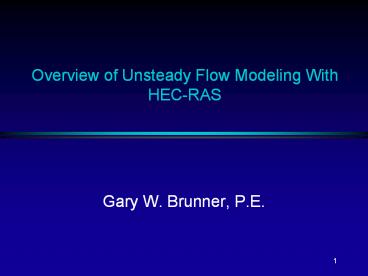Overview of Unsteady Flow Modeling With HEC-RAS - PowerPoint PPT Presentation
Title:
Overview of Unsteady Flow Modeling With HEC-RAS
Description:
Post-processor. Additional graphics/tables to view results ... Bridge Hydraulic Properties Plot. 9. Boundary and Initial Conditions ... Post-processing Results ... – PowerPoint PPT presentation
Number of Views:1500
Avg rating:3.0/5.0
Title: Overview of Unsteady Flow Modeling With HEC-RAS
1
Overview of Unsteady Flow Modeling With HEC-RAS
- Gary W. Brunner, P.E.
2
Introduction
- Overview
- New Geometric Features for HEC-RAS
- Geometric pre-processor
- Boundary and initial conditions
- Unsteady flow simulation manager
- Post-processor
- Additional graphics/tables to view results
3
Overview
- Common geometry and hydraulic computations for
steady unsteady flow - Using the UNET equation solver (Dr. Robert
Barkau) - Can handle simple dendritic streams to complex
networks - Able to handle a wide variety of hydraulic
structures - Extremely fast matrix solver
4
New Geometric Features for RAS
- Existing Geometric Features all work for unsteady
flow (XS, bridges, Culverts, inline
weirs/spillways) - Lateral Weirs/Spillways
- Storage Areas
- Storage Area Connections (weirs, gated spillways,
and culverts) - Pump Stations
5
Pre-processing Geometry
- For unsteady flow, geometry is pre-processed into
tables and rating curves - Cross sections are processed into tables of area,
conveyance, and storage - Bridges and culverts are processed into a family
of rating curves for each structure - Weirs and gated structures are calculated on the
fly during unsteady flow calculations - Pre-processor results can be viewed in graphs and
tables
6
Cross Section Properties Plot
Property Table
RS 138154.4
700
Legend
Conv. Channel
690
Conv. Valley
Conv. Total
680
Storage
Elevation (ft)
670
660
650
0
1000
2000
3000
4000
5000
6000
7000
Conveyance/1000 (cfs) Storage (cu ft)
7
Cross Section Properties Table
8
Bridge Hydraulic Properties Plot
9
Boundary and Initial Conditions
- Boundary conditions must be established at all
ends of the river system - Flow hydrograph
- Stage hydrograph
- Flow and stage hydrograph
- Rating curve
- Normal depth
10
Boundary and Initial Conditions
- Interior boundary conditions can also be defined
within the river system - Lateral inflow to a node
- Uniform lateral inflow across a reach
- Ground water interflow
- Time series of gate openings
- Elevation controlled gate
- Navigation Dams
- Observed internal stage and/or flow hydrograph
11
Boundary and Initial Conditions
- Initial conditions must be established for the
entire system - Specify flows and perform a steady flow backwater
analysis - Read in flow and stage at every node from a
previous run, hot start file
12
Unsteady Flow Simulation Simulation Manager
1. Define a Plan
2. Select which programs to run
3. Enter a starting and ending date and time
4. Set the computation settings
5. Press the Compute button
13
HEC-RAS Computation Window
Geometric Pre-Processor
Unsteady Flow Simulation
Post Processor
Computational Messages
14
Simulation Options
- Stage and Flow Output Locations
- Flow Distribution Locations
- Flow - Roughness Change Factors
- Seasonal Roughness Factors
- Friction Slope Method
- Output Options
- Write out Restart File
- Detailed Log level output
15
Simulation Options- Continued
- Encroachments - Method 1 Only
- Dam Breaching
- Levee Breaching
- Mixed Flow Regime
- Checking Data Before Computations
- Viewing Computation Log File
16
Calculation Options and Tolerances
17
Post-processing Results
- Used to compute detailed hydraulic information
for a set of user-specified time lines and an
overall maximum water surface profile. - Computed stages and flows are passed to the
steady flow program for the computation of
detailed hydraulic results
18
Viewing Unsteady Flow Results
- All of the output that was available for steady
flow computations is available for unsteady flow
(cross sections, profile, and 3D plots and
tables). - Stage and flow hydrographs
- Time series tables
- Animation of cross section, profile and
3-dimensional graphic
19
Stage and Flow Hydrograph
20
Time Series Table
21
Animation of Profile Plot
22
HEC-RAS Demonstration

























![Blood Flow Measurement Devices Market Report [2016-2021] PowerPoint PPT Presentation](https://s3.amazonaws.com/images.powershow.com/9400200.th0.jpg?_=20200217018)





